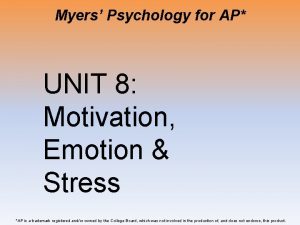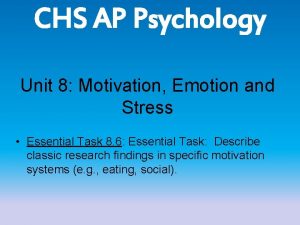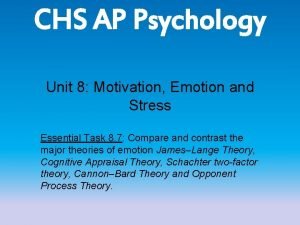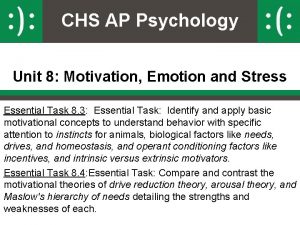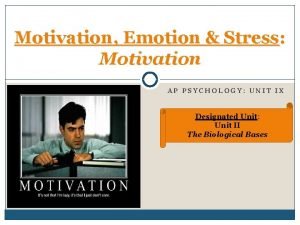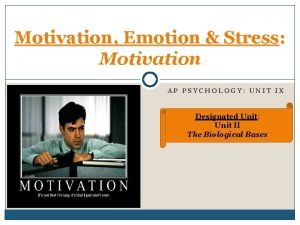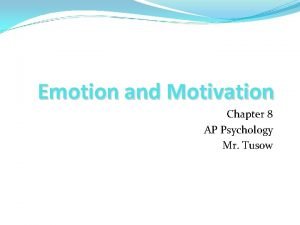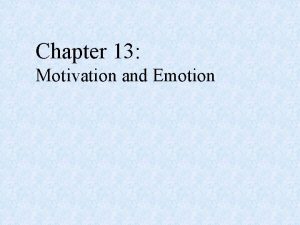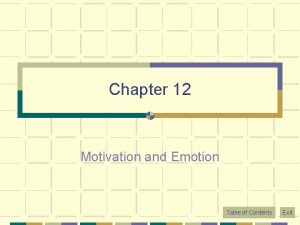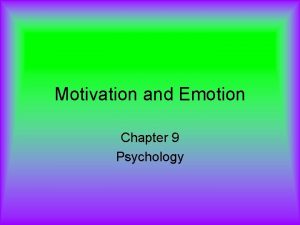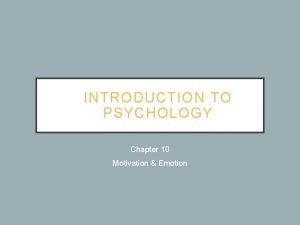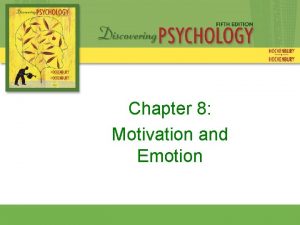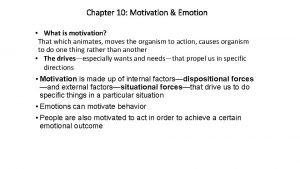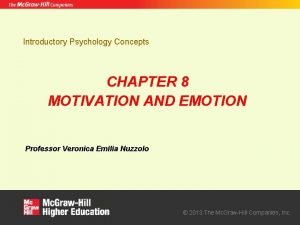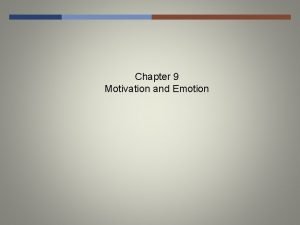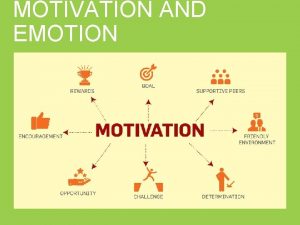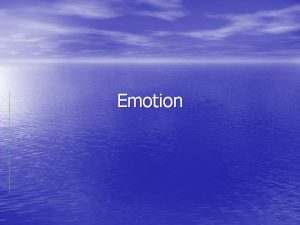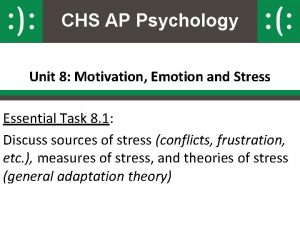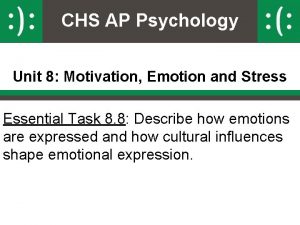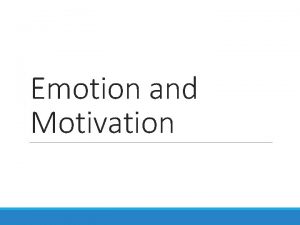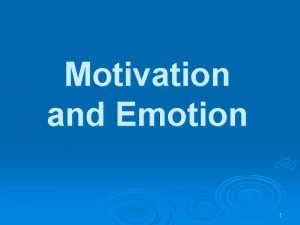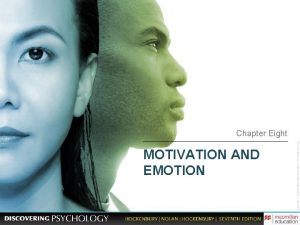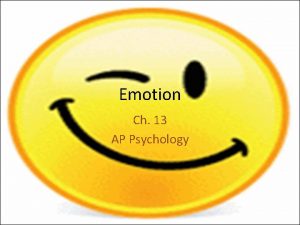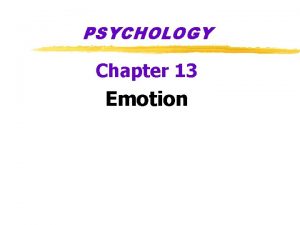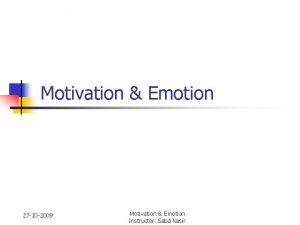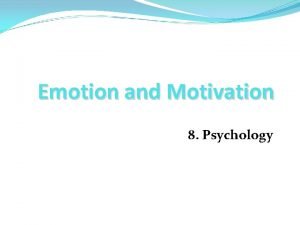CHS AP Psychology Unit 8 Motivation Emotion and
















- Slides: 16

CHS AP Psychology Unit 8: Motivation, Emotion and Stress Essential Task 8. 7: Compare and contrast the major theories of emotion James–Lange Theory, Cognitive Appraisal Theory, Schachter two-factor theory, Cannon–Bard Theory and Opponent Process Theory.

Emotion • The experience of feelings • A response of the whole organism involving physiological arousal, expressive behaviors, and conscious experience

Basic Emotions • How many emotions can you name? • Plutchik proposed that there are eight basic emotions • • Fear Surprise Sadness Disgust • • Anger Anticipation Joy Acceptance

Plutchik’s Basic Emotions

Basic Emotions • Some have criticized Plutchik’s model as applying only to English-speakers • Devised Primary vs. Secondary Emotions – – Be evident in all cultures Contribute to survival Distinct facial expression Evident in Nonhuman primates • Revised model of basic emotions includes: – – – Happiness Surprise Sadness Fear Disgust Anger


Theories 1. James-Lange Theory 2. Cannon-Bard Theory 3. Two-Factor (Schachter-Singer) Theory

James-Lange Theory William James and Carl Lange proposed an idea that was diametrically opposed to the common-sense view. The James. Lange Theory proposes that physiological activity precedes the emotional experience.

James-Lange theory Body = emotion “Without the bodily states following on the perception, the latter would be purely cognitive in form; pale, colorless, destitute of emotional warmth. We might then see the bear, and judge it best to run. . . But we should not actually feel afraid. ” (William James, 1890) James, 1890, v. 2, p. 449 (Gleitman)

James-Lange : Testing the Theory • Test #1: Interviewed people with high vs. low spinal cord injuries High spinal cord injury: “Sometimes I act angry. . . But it doesn’t have the heat to it that it used to. It’s a mental kind of anger. ” Hohman, 1966, pp. 150 -151 (Carlson) • Test #2: Gave adrenaline shots to people “I feel as if I’m angry or afraid. ” • The idea is that you need your body in order to feel the full emotional experience.

James-Lange theory • Situation bodily reaction emotion FEAR or LOVE?

Cannon-Bard Theory Walter Cannon and Phillip Bard questioned the James-Lange Theory and proposed that an emotiontriggering stimulus and the body's arousal take place simultaneously.

Cannon-Bard Theory • See snake, run and fear simultaneous • Stimulus to thalamus -- sends simultaneous messages to: – Lymbic system (arousal) – Cortex (fear)

Also known as the Schachter-Singer Theory Two-Factor Theory • Stanley Schachter and Jerome Singer proposed yet another theory which suggests our physiology and cognitions create emotions. • Emotions have two factors–physical arousal and cognitive label.

Two-Factor Theory • Situation bodily reaction emotion + cognitive appraisal FEAR LOVE

Spill over effect An arousal response to one event spills over into our response to the next event. Spill over effect Arousal from a soccer match can fuel anger, which may lead to rioting. Arousal fuels emotion, cognition channels it.
 Anorexia nervosa ap psychology definition
Anorexia nervosa ap psychology definition Ap psychology unit 8 motivation emotion and stress
Ap psychology unit 8 motivation emotion and stress Ap psychology unit 8 motivation and emotion test
Ap psychology unit 8 motivation and emotion test Homeostasis ap psychology
Homeostasis ap psychology Ap psychology motivation and emotion activities
Ap psychology motivation and emotion activities Ap psychology motivation and emotion
Ap psychology motivation and emotion 2 factor theory of emotion
2 factor theory of emotion Incentive theory ap psychology
Incentive theory ap psychology Unit 8 motivation and emotion
Unit 8 motivation and emotion Chapter 13 motivation and emotion
Chapter 13 motivation and emotion Chapter 12 motivation and emotion
Chapter 12 motivation and emotion Carroll izard 10 basic emotions
Carroll izard 10 basic emotions Paul ekman universal facial expressions
Paul ekman universal facial expressions Cognitive appraisal
Cognitive appraisal Chapter 10 motivation and emotion
Chapter 10 motivation and emotion Chapter 8 motivation and emotion
Chapter 8 motivation and emotion Chapter 9 motivation and emotion quiz
Chapter 9 motivation and emotion quiz
